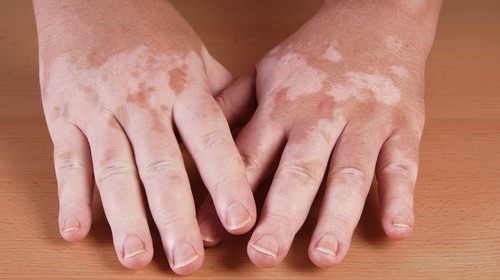
Vitiligo
What Is Vitiligo?
Vitiligo (vit-ill-EYE-go) is a pigmentation disorder in which melanocytes (the cells that make pigment) in the skin, the mucous membranes (tissues that line the inside of the mouth and nose and genital and rectal areas), and the retina (inner layer of the eyeball) are destroyed. As a result, white patches of skin appear on different parts of the body. The hair that grows in areas affected by vitiligo usually turns white.
The cause of vitiligo is not known, but doctors and researchers have several different theories. One theory is that people develop antibodies that destroy the melanocytes in their own bodies. Another theory is that melanocytes destroy themselves. Finally, some people have reported that a single event such as sunburn or emotional distress triggered vitiligo; however, these events have not been scientifically proven to cause vitiligo.
Who Is Affected by Vitiligo?
About 1 to 2 percent of the world’s population, or 40 to 50 million people, have vitiligo. Ninety-five percent of people who have vitiligo develop it before their 40th birthday. The disorder affects all races and both sexes equally.
Vitiligo seems to be more common in people with certain autoimmune diseases (diseases in which a person’s immune system reacts against the body’s own organs or tissues). These autoimmune diseases include hyperthyroidism (an overactive thyroid gland), adrenocortical insufficiency (the adrenal gland does not produce enough of the hormone called corticosteroid), alopecia areata (patches of baldness), and pernicious anemia (a low level of red blood cells caused by failure of the body to absorb vitamin B-12However, most people with vitiligo have no other autoimmune disease.
Vitiligo may also be hereditary, that is, it can run in families. Children whose parents have the disorder are more likely to develop vitiligo. However, most children will not get vitiligo even if a parent has it, and most people with vitiligo do not have a family history of the disorder.
What Are the Symptoms of Vitiligo?
People who develop vitiligo usually first notice white patches (depigmentation) on their skin. These patches are more common in sun-exposed areas, including the hands, feet, arms, face, and lips. Other common areas for white patches to appear are the armpits and groin and around the mouth, eyes, nostrils, navel, and genitals.
Will the Depigmented Patches Spread?
There is no way to predict if vitiligo will spread. For some people, the depigmented patches do not spread. The disorder is usually progressive, however, and over time the white patches will spread to other areas of the body. For some people, vitiligo spreads slowly, over many years. For other
people, spreading occurs rapidly. Some people have reported additional depigmentation following periods of physical or emotional stress.







Most Commented